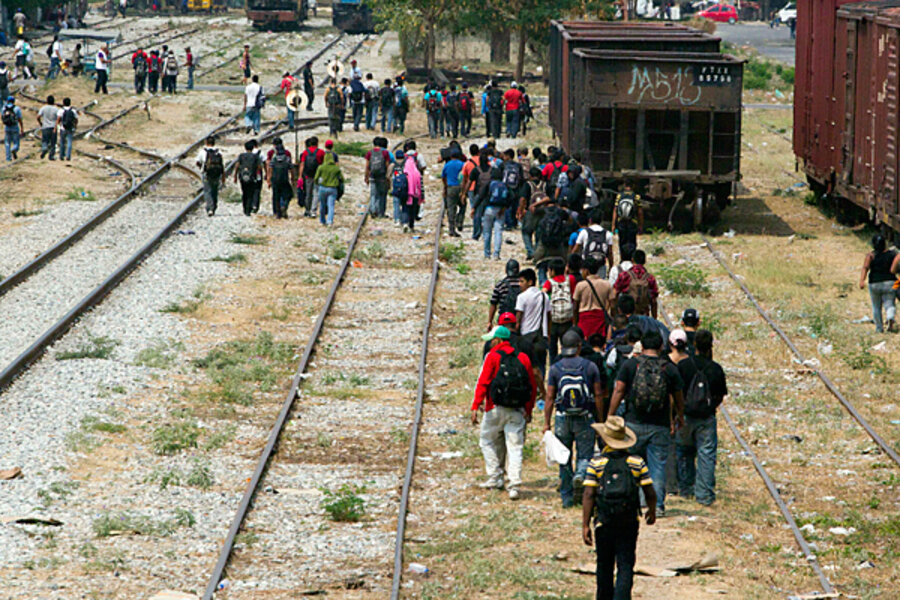Perils en route to US mean more Central Americans now pin hopes on Mexico
Loading...
| MEXICO CITY
Long an advocate for immigrant rights in the US, Mexico is increasingly following its northern neighbor's footsteps, opting for apprehensions and heightened security along its southern border. It's there that hundreds of Central American migrants begin the treacherous journey north – a route that has become so risky that increasing numbers are choosing to try their luck in Mexico.
President Enrique Peña Nieto's promises to strengthen security at the country’s historically porous southern boundary came into focus last week with the announcement that the Marines will coordinate border security at the more than 620-mile border with Guatemala and Belize.
The route to el norte, the United States, is more dangerous and costly than ever. Over the past eight months, rights workers say criminals associated with Mexico’s Zetas drug cartel have taken control of the freight train route from Tabasco at the southern border to Tamaulipas in the north, the crossing point to the United States. Migrants face robbery, extortion, kidnapping, and death threats. Just last week the National Migration Institute said it rescued 165 migrants allegedly being held in Tamaulipas.
“I was afraid they’d kill me at the border,” says Manuel, who, a year and a half ago, made the journey north from his home in Guatemala but stopped short of crossing into the US.
The 20-year-old, who requested his full name be withheld for security reasons, said in a telephone interview that he feared the violence of Mexico's ruthless drug cartels. He now works illegally at a tortilla shop in the northern city of Monterrey.
Rights workers say a 2011 immigration law designed to protect migrants’ rights – passed after a massacre of 72 migrants in Tamaulipas came to light – places what amount to insurmountable obstacles for most Central Americans to obtain transit documents or work visas here.
“What’s going to go up is the number of people who are here undocumented,” says Lorena Cano, who provides legal support to migrants through the nonprofit Sin Fronteras in Mexico City. Mexico has a long tradition of accepting immigrants, including refugees during the Central American civil wars of previous decades. But Ms. Cano says the new law essentially mirrors the current US system, leaving migrants few choices but to work illegally.
Of the migrants who stay, many are doing jobs locals don’t want to do. In northern Mexico, Central American migrants are working in cleaning services, in markets stocking fruit and vegetables, in carpentry, and in catering, says José Luis Manzo of the Casa del Migrante Saltillo in Coahuila. The few who have chosen to stay in Mexico City and apply for refugee or humanitarian visas are working in cleaning and construction, according to Sin Fronteras.
“Many prefer to remain clandestine,” says Mr. Manzo.
A fundamental shift
US Border Patrol apprehensions of undocumented Mexicans at the southwest border have fallen steadily from nearly 1 million in fiscal year 2004 to about 262,341 in 2012. The number of people from countries other than Mexico picked up on the same border – the majority from Honduras, Guatemala, and El Salvador – climbed 43 percent over the same period, to more than 94,532 last year.
The ailing US economy helped discourage Mexicans from heading north in recent years, but analysts say it’s more than that. A fundamental demographic shift – specifically a fertility rate that has fallen from more than seven children per family in the 1960s to just two today – means that Mexico has likely seen its last demographic bubble. The next generation of young people will be smaller than the current generation. Mexico’s job market, seen as improving along with a growing economy, won’t have to satisfy outsized demand for job opportunities.
“This is more than a blip on a screen,” says Doris Meissner, senior fellow at the Washington, DC-based Migration Policy Institute. “Those are structural changes that should mean that even if [US] job availability and demand picks up a little bit – which is only happening very slowly – it’s not likely to generate the same level of heated flow of low wage and low skill workers from Mexico.”
But the same doesn’t hold true for Guatemala and Honduras, where fertility rates are still high and the populations are younger. Both countries, along with El Salvador, are plagued by violence and extreme poverty that drive people to seek opportunity elsewhere, even if it means taking a treacherous journey north.
A costly journey
Gang members, reportedly Maras from Central America backed by the Zetas, extort migrants from Guatemala, Honduras, and El Salvador out of $100 to $300 per freight train stop in Mexico. By the time the train skirts Mexico City, the journey may cost migrants up to $800. Those who fail to pay risk being thrown from the train. This is before accounting for the costs of paying smugglers at the border that help migrants enter the US.
“The fact that [gang members] rob them along the whole journey forces [migrants] to find work in order to keep going,” says Marta Sanchez, director of the nonprofit Mesoamerican Migrant Movement.
“They may not have completely abandoned their dream to cross to the United States,” says Manzo. “It could be that they found a way to subsist in Mexico before crossing, or that their families in the US or back home stopped supporting them.”
Earlier this month, authorities arrested nine Hondurans for the murder of two Honduran women on the freight train route in Mexico’s southern Chiapas state and the deaths of other migrants who refused to pay extortion charges.
‘More opportunity’ in Mexico
“There is so much violence in Guatemala, too much violence,” says Manuel, the young man who stopped his journey short of the US. “A lot of organized crime. It’s here, too, but there is more opportunity.”
Manuel says he has given up plans to reach the US and wants to stay in Mexico. The National Migration Institute (INM) denied his application for a humanitarian visa, which can be granted to victims of serious crimes. He says he was kidnapped and robbed by Mexican federal police and has appealed the decision.
Under the current law, migrants may apply to reside legally in Mexico by marrying a local or having children here. Minors and refugees are also eligible for visas. But a proven job offer is no longer a path to legal residency as it was under the previous system.
“I want to be legal, and I’m trying,” Manuel says. “Here they treat us like garbage. They don’t see us as people.”
The number of migrants of all nationalities given authorization papers by INM in the first three months of the year was down by nearly half compared with the same period in 2010, falling to about 56,000 from 101,000, according to Sin Fronteras.
Meanwhile, the INM has reported apprehending more than 400 undocumented Central American migrants since March, not including the reported rescue of 165 mostly Central American migrants in Tamaulipas. The INM did not respond to requests for an interview.
In announcing the Marines' role in securing the southern border, Interior Ministor Miguel Osorio Chong said one thing Mexico will not do is build a border wall. Public policies will center on providing attention to migrants, and controlling the border. The idea, he said, is to help migrants to "prevent that they suffer or that they have any problem in our country."








